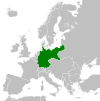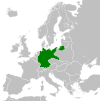德意志国
| 德国历史 |
|---|
 |
| 历史系列条目 |
德意志国(德语:Deutsches Reich/英语:German Empire或German Reich[1]),是德国1871年至1943年的正式国号,1943年至1945年则为“大德意志国”(Großdeutsches Reich)。为现今德意志联邦共和国的前朝。
名称
[编辑]“Reich”之词源为拉丁语“rēx”(王),与英语中“realm”一词相当。最初,“Reich”一词由神圣罗马帝国[2]所使用,“Reich”一词指的是一个或多个君主的统治范围,而不论其规模或权力如何[3]。其义约等于“帝国”。王国则冠之以国王“König”一词呼曰“Königreich”,如普鲁士王国(Königreich Preußen)和巴伐利亚王国(Königreich Bayern)。
1871年1月18日,普鲁士国王威廉一世在巴黎凡尔赛宫镜厅登基为德意志皇帝,国号定为“Deutsches Reich”。
随一次世界大战爆发,德国受战争引发政治动荡导致君主制瓦解,威玛共和建立。中央党赞成使用“Deutscher Volksstaat”(德意志人民国)作为新政权的名称而温和左翼社民党籍总理弗里德里希·艾伯特则倾向于使用“Deutsche Republik”(德意志共和国)[4]。进行政治活动的右翼抗拒新的民主体制,渴望祖国当年的荣耀再现,所以重视“Reich”这一历史悠久的国名所承载的意义,希望保留之[4]。没有一个统一的名称能被广泛接受。其后制定的威玛宪法第一条规定“Deutsches Reich 为共和制”("Das Deutsche Reich ist eine Republik."[5]),为使保守且传统的德国社会能够接受[6],其为实施维持君主象征之广义上的君主立宪变体,旧国名“Deutsches Reich”被保留。“联邦大总统”被认为是“代理皇帝”(Ersatzkaiser),下议院仍沿用帝国议会旧称“Reichstag”,政府法律公告沿袭“帝国法律公报”(Reichsgesetzblatt)[7]。当时的法学家奥特马尔·布勒解释称,“Reich意为德意志‘全国’”,接近英语的“commonwealth”或“nation”[6]。在这之后,“Reich”的主要语义变为“大的国家”,其原义“君主国”“帝国”退居次要含义[8]。
尽管如此,民间几乎没有人使用“Deutsches Reich”[9],在外国人眼里也不免对一个共和国仍然自称“Reich”感到怪异[10]。到1925年时,大多数德国人都使用“Deutsche Republik”称呼自己的国家。
历史学家理查德·J·埃文斯称:“威玛共和继续使用‘Deutsches Reich’一词……在受过良好教育的德国人间产生了一种印象,这种印象远远超出俾斯麦所建立的体制结构:罗马帝国的继承者、地上天国的幻景、其所宣称的宗主权的普遍性、还有一个更平淡无奇但又有力的含义──一个会将中欧所有讲德语者全包含进来的德意志国家──‘一个民族,一个国家,一个元首’,正如纳粹党的口号所言。”[11]
因亚瑟·莫勒·范登布鲁克所著《第三帝国》,“Reich”一词在右翼思想家里有了特别的意涵。纳粹党执政后不仅延续了“Deutsches Reich”的国号,更以“Drittes Reich”(常译为“第三帝国”)为口号作宣传,宣称自己是继承了神圣罗马帝国(Heiliges Römisches Reich Deutscher Nation)和德意志帝国这两个以“Reich”为名的政权的第三个“Reich”。
因使用“Deutsches Reich”作为国名的政权有着不同政治制度,包含时间跨度甚大的历史时期,“Reich”在历史上的含义也不一而足,故其中文通译为“德意志国”。
东西德以及现在的联邦德国政府皆不使用“Reich”一词[12]。威玛及纳粹时期冠有“Reich”的职位和机构也都被更名[13]。
在现代德语里,若要强调一国为帝国时则以皇帝“Kaiser”一词冠之呼曰“Kaiserreich”。1871-1918年的德意志国通常被称作“Deutsches Kaiserreich”。王国为“Königreich”。历史上的称呼“Frankreich”(法国,直译为法兰西帝国)和“Österreich”(奥地利,直译为“东边的帝国”)仍在使用。
变迁
[编辑]帝政期
[编辑]1871年至1918年由霍亨索伦王朝统治,通称“德意志帝国”(德语:Deutsches Kaiserreich/英语:German Empire)。
威玛共和期
[编辑]1918年至1933年处于威玛宪法确立下的国家体制。通称“威玛共和国”(德语:Weimarer Republik/英语:Weimar Republic)。
纳粹执政期
[编辑]1933年至1945年,国家社会主义德国工人党(纳粹党)治下的德国。通称“纳粹德国”(德语:Nazi-Deutschland/英语:Nazi Germany)
德国崩溃后,盟军于1945年6月5日发表《柏林宣言》,宣布德国中央政府已不存在,德意志国灭亡。其后成立的德意志联邦共和国(西德)和德意志民主共和国(东德)皆未继承“Deutsches Reich”的国号,德意志国从此走入历史。
列表
[编辑]| 政权 | 存续日期 | 政治体制 | 国家元首 | 政府首脑 | 国旗 | 货币 | 国歌 | 领土 |
|---|---|---|---|---|---|---|---|---|
| 1871年 – 1918年 | 联邦君主制 二元制君主立宪制(1916年8月前) 军事独裁下的二元制君主立宪制(1916年8月 – 1918年11月) |
德意志皇帝 Deutscher Kaiser |
帝国总理 Reichskanzler |
 (1892年 – 1918年) |
邦联银元 Vereinsthaler 南德意志金元 Gulden 不莱梅银元 Thaler 汉堡马克 Hamburger Mark 法国法郎 franc français (至1873年共同使用) 黄金马克 Mark (1873年 – 1914年) 纸马克 Papiermark (1914年 – 1918年) |
《万岁胜利者的桂冠》 "Heil dir im Siegerkranz" |

| |
| 1918年 – 1933年 | 联邦制、半总统制、共和制(1919年 – 1930年) 威权政体、总统制(1930年 – 1933年) |
联邦大总统 Reichspräsident |
总理 Reichskanzler |
 (1919年8月14日 – 1933年) |
纸马克 Papiermark (1919年 – 1923年) 地租马克 Rentenmark (1923年 – 1933年) 国家马克 Reichsmark (1924年 – 1933年) |
《德意志人之歌》 "Das Lied der Deutschen" |

| |
| 1933年 – 1945年 | 国家社会主义 一党制 极权主义 独裁政体 |
联邦大总统 Reichspräsident (1933年 – 1934年) 元首 Führer (1934年 – 1945年) 总统 Reichspräsident (1945年) |
总理 Reichskanzler |   (1933年3月12日 – 1935年9月15日)  (1935年9月15日 – 1945年) |
国家马克 Reichsmark (1924年 – 1948年6月20日) |
《德意志人之歌》 "Das Lied der Deutschen" 《霍斯特·威塞尔之歌》 "Horst-Wessel-Lied" |

|
脚注
[编辑]- ^ “German Empire”用以指1871-1918年帝政期的德意志国,“German Reich”则特指1933-1945年纳粹党掌权的德意志国。为了区别两者,英文直接借用德文“Reich”一词。
- ^ 腓特烈三世〜马克西米连一世,“德意志人的神圣罗马帝国”(Heiliges Römisches Reich Deutscher Nation)。国号里的“德意志人”(Deutscher Nation)不是种族概念,而是指诸侯、市民、骑士等拥有帝国身份的人(坂井榮八郎『ドイツの歴史百話』84页)。
- ^ Schulze2005, p2
- ^ 4.0 4.1 Sebastian Ullrich as quoted by Eva-Maria Schnurr. Der Name des Feindes: Warum heißt der erste deutsche Demokratie eigentlich "Weimarer Republik?". Der Spiegel. Vol. 5/2014 Der Spiegel – Geschichte 3 Hausmitteilung 137 Impressum. September 2014: 20.
- ^ Die Verfassung des Deutschen Reichs, Erster Abschnitt: Reich und Länder, Artikel 1
- ^ 6.0 6.1 间崎万里 1939,第199页.
- ^ 公報法制化之研究 (PDF). 行政院研究发展考核委员会: 66. 2009-03. (原始内容存档 (PDF)于2014-04-19) –通过国家发展委员会 (中文(台湾)).
- ^ 间崎万里 1939,第205-206页.
- ^ Eva-Maria Schnurr. Der Name des Feindes: Warum heißt der erste deutsche Demokratie eigentlich "Weimarer Republik?". Der Spiegel. Vol. 5/2014 Der Spiegel – Geschichte 3 Hausmitteilung 137 Impressum. September 2014: 20.
- ^ 间崎万里 1939,第196-200页.
- ^ Richard J. Evans. The Coming of the Third Reich. Penguin. 2005: 33 [2019-10-03]. ISBN 9781101042670. (原始内容存档于2018-05-04).
- ^ 但是,东德为主张对战前德意志国营铁路的继承性,国有铁路继续使用“Deutsche Reichsbahn”的名称。
- ^ 西德以意为“联邦”的“Bund”和“Bundes”作为前缀,以取代“Reich”和“Reichs”。例如联邦总理(Bundeskanzler)和联邦总统(Bundespräsident)。
东德以相当于英语“state”的“Staat”和“Staats”作为前缀,以取代“Reich”和“Reichs”。例如1960年以后作为东德国家元首的国务委员会(Staatsrat)、秘密警察机构国家安全部(Ministerium für Staatssicherheit)等等。
参考文献
[编辑]- 間崎万里. Empire, Reichの新用法とその語義及び譯語について. 史学 (三田史学会). 1939,. 18( No.2/3): 187–232 [2019-10-03]. (原始内容存档于2022-02-01).
- ハンス・K・シュルツェ. 西欧中世史事典Ⅱ 皇帝と帝国. ミネルヴァ書房. 2005. ISBN 9784623039302.
| |||||||||||||||||
Text is available under the CC BY-SA 4.0 license; additional terms may apply.
Images, videos and audio are available under their respective licenses.






